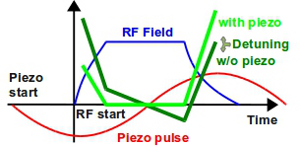
Two piezoelectric tuners, the smaller horizontal pieces wrapped in tape, are shown fixed to the end of a superconducting accelerating cavity. Image: DESY
Accelerator scientists have been busy creating and combining sine waves and nonlinear curves to form a straight, horizontal line – the flat top of a signal pulse of electric field-accelerating electrons. The flat, even profile signifies the untroubled transfer of power from source to electrons, one that occurs when a cavity is in tune with the accelerator’s needs.
During last February’s 9 milliamp tests at DESY’s FLASH facility, DESY scientists used an automated piezoelectric system to successfully tune ILC-type cavities to within several ten-thousandths of a percent of their resonant frequency. It was the first time this system was able to tune the cavity so closely to resonance, 1.3 gigahertz. Mariusz Grecki of DESY’s Machine Beam Control (MSK) group presented their results at the May long bunch train workshop.
“Having an automatic procedure that keeps the cavity tuned to the resonant frequency is a great success,” Grecki said. The more resonant the cavity’s frequency is with that of the power being fed to it, the more readily it accepts it and the less power is wasted.
“The piezo tuners are all about saving radiofrequency power, and therefore both capital and running costs,” said DESY’s Nick Walker, project manager for the ILC.
A piezoelectric tuner, or ‘piezo’ for short, converts electromagnetic signals into tiny mechanical movements. Fixed to the ends of meter-long superconducting cavities, these Lego block-sized devices ping the cavity to stretch or contract its length by nearly imperceptible amounts – only micrometres. The small change in shape makes a significant difference in the cavity’s frequency.
The necessity of sculpting the cavity arises from an unfortunate, unavoidable phenomenon called Lorentz force detuning: every time a cavity is filled with electric field, the Lorentz force pushes apart atoms in the cavity wall, changes its shape and so brings it out of tune.
By feeding the right signals to the piezo, scientists counteract the frequency changes that come from detuning and ping it back to its desired shape. If all goes well, the voltage signals to the piezo result in an exact cancellation of the signal that arises from the cavity’s Lorentz force deformation, resulting in a nice, flat pulse top that lasts for as long as the beam is accelerated in the cavity – about 800 microseconds.
The MSK team was able to nearly fully compensate for the detuning, achieving signal that was within 10 hertz of the resonant 1.3-gigahertz (1,300,000,000 hertz) frequency. With the superconducting cavities so close to resonance, power can flow freely from the power station to the cavity without fear or annoyance of being bounced back.

Lorentz force detuning deforms the cavity shape and, therefore, its frequency. Image: Mariusz Grecki
Other ILC collaborators have also been working to overcome Lorentz force detuning. A Fermilab group, for example, achieved similar results using different algorithms.
More work remains to combat related nuisances. A different phenomenon called microphonics – small vibrations from sources outside the accelerator tunnel, like a train passing by – also detunes the cavity. An additional piezo could help compensate for these little disturbances.
“The microphonics contribution is a lot smaller compared to Lorentz force detuning, but it exists,” Grecki said. It could alter the cavity frequency by a few hertz, an incredibly tiny departure from resonance: if your wristwatch were off by a comparable degree, you’d reset it once every few years to be correct to the second.
That’s why piezos are handy. Like the smaller screws at the bases of violin strings, the piezo acts as a fine tuner.
“The piezo tuner is pretty much the only ‘knob’ we have on each cavity to fight detuning,” Walker said. Other control systems regulate the electric field over groups of cavities.

The blue curve represents the desired pulse shape of the accelerating field in the cavity. Image: Mariusz Grecki
Having experimentally determined a method for detuning, DESY scientists are also working on the pencil-and-paper calculation for predicting the cavity’s tune when it’s loaded with a particle beam. (They’ve already hit upon the tuning calculation for a cavity that’s absent beam.) The very presence of beam complicates the equation substantially, and researchers continue to search for detuning’s correct expression.
The detuning studies for the 9-mA experiments at FLASH provide ILC researchers with methods for saving power and reducing cost. And because they require the FLASH accelerator to increase its beam current from what it’s accustomed to providing to its regular users, the 9-mA experiments also gives the FLASH programme a chance to show sides of itself that it otherwise wouldn’t.
“The ILC needs experiments with the highest possible accelerating gradients and the highest possible beam current. At FLASH, we don’t usually use such high current,” Grecki said. “It was a very good opportunity to make a check-out of equations for beam contribution – the perfect situation to make such calculations.”

how do u do analysis of detuning. can u explane it..it will be very kind.